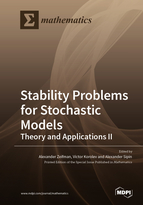Stability Problems for Stochastic Models: Theory and Applications II
A special issue of Mathematics (ISSN 2227-7390). This special issue belongs to the section "E1: Mathematics and Computer Science".
Deadline for manuscript submissions: closed (31 December 2021) | Viewed by 29378
Special Issue Editors
2. Institute of Informatics Problems of the Federal Research Center “Computer Science and Control”, Russian Academy of Sciences, 119333 Moscow, Russia
3. Vologda Research Center of the Russian Academy of Sciences, 160014 Vologda, Russia
Interests: stochastic models; continuous-time Markov chains; queueing models; biological models
Special Issues, Collections and Topics in MDPI journals
2. Moscow Center for Fundamental and Applied Mathematics, 119991 Moscow, Russia
3. Federal Research Center “Informatics and Control” of the Russian Academy of Sciences, 119333 Moscow, Russia
Interests: stochastic models; risk processes; queueing theory; limit theorems
Special Issues, Collections and Topics in MDPI journals
Interests: stochastic models; monte carlo methods
Special Issues, Collections and Topics in MDPI journals
Special Issue Information
Dear Colleagues,
The aim of this Special Issue is to publish original research articles that cover recent advances in probability theory, stochastic processes, mathematical statistics, and their applications. The focus will especially be on stability problems related to this field, including treatment of limit theorems as the source of practical approximations, applications of limit distributions as probability models of statistical regularities in observed data, and stochastic processes as models of dynamic phenomena in various research areas, such as queuing theory, physics, biology, economics, medicine, reliability theory, and financial mathematics.
Potential topics include but are not limited to the following:
- Limit theorems and stability problems;
- Asymptotic theory of stochastic processes;
- Stable distributions and processes;
- Asymptotic statistics;
- Discrete probability models;
- Characterizations of probability distributions;
- Insurance and financial mathematics;
- Applied statistics;
- Queueing theory including queueing network models;
- Markov chains and processes;
- Large deviations and limit theorems;
- Random motions;
- Stochastic biological models;
- Reliability, availability, maintenance, and inspection;
- Computational methods for stochastic models.
Prof. Dr. Alexander Zeifman
Prof. Dr. Victor Korolev
Prof. Dr. Alexander Sipin
Guest Editors
Manuscript Submission Information
Manuscripts should be submitted online at www.mdpi.com by registering and logging in to this website. Once you are registered, click here to go to the submission form. Manuscripts can be submitted until the deadline. All submissions that pass pre-check are peer-reviewed. Accepted papers will be published continuously in the journal (as soon as accepted) and will be listed together on the special issue website. Research articles, review articles as well as short communications are invited. For planned papers, a title and short abstract (about 100 words) can be sent to the Editorial Office for announcement on this website.
Submitted manuscripts should not have been published previously, nor be under consideration for publication elsewhere (except conference proceedings papers). All manuscripts are thoroughly refereed through a single-blind peer-review process. A guide for authors and other relevant information for submission of manuscripts is available on the Instructions for Authors page. Mathematics is an international peer-reviewed open access semimonthly journal published by MDPI.
Please visit the Instructions for Authors page before submitting a manuscript. The Article Processing Charge (APC) for publication in this open access journal is 2600 CHF (Swiss Francs). Submitted papers should be well formatted and use good English. Authors may use MDPI's English editing service prior to publication or during author revisions.
Benefits of Publishing in a Special Issue
- Ease of navigation: Grouping papers by topic helps scholars navigate broad scope journals more efficiently.
- Greater discoverability: Special Issues support the reach and impact of scientific research. Articles in Special Issues are more discoverable and cited more frequently.
- Expansion of research network: Special Issues facilitate connections among authors, fostering scientific collaborations.
- External promotion: Articles in Special Issues are often promoted through the journal's social media, increasing their visibility.
- Reprint: MDPI Books provides the opportunity to republish successful Special Issues in book format, both online and in print.
Further information on MDPI's Special Issue policies can be found here.








